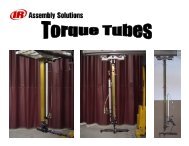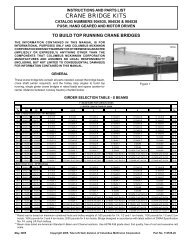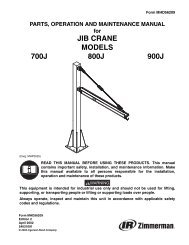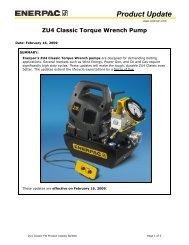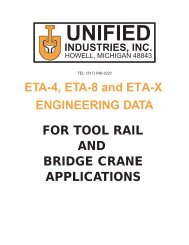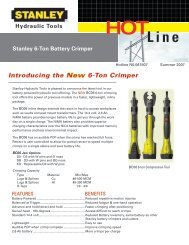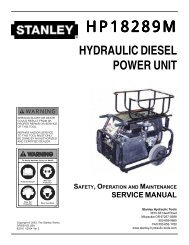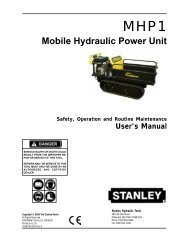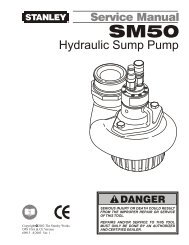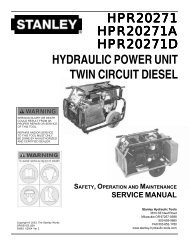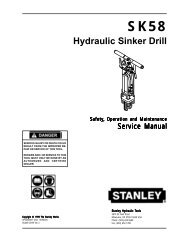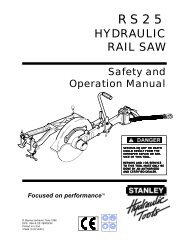ingersoll rand aro compact series - ToolSmith
ingersoll rand aro compact series - ToolSmith
ingersoll rand aro compact series - ToolSmith
Create successful ePaper yourself
Turn your PDF publications into a flip-book with our unique Google optimized e-Paper software.
42 | INGERSOLL RAND • SIMPLAIR PIPING<br />
SIMPLAIR EL Details<br />
Working Temperature Range<br />
• Minimum working temperature - 4° F (-20° C)<br />
• Maximum working temperature +140° F (+60° C)<br />
The above working temperatures apply to compressed<br />
air applications only.<br />
Working Pressure<br />
• Maximum working pressure 150 psi (10 bar)<br />
Material Specification<br />
The fittings are made up of three components:<br />
• Bodies are produced in strong engineered plastic or<br />
in brass<br />
• O-rings are made of nitrile rubber<br />
• Collets are made of in acetal copolymer with stainless<br />
steel teeth<br />
Standards<br />
• Tested to ANSI B31.1<br />
Applications<br />
These products are designed for use with compressed air.<br />
For other applications, please refer to our customer<br />
services department.<br />
Installation Guide — Code of Practice<br />
When installing a compressed air piping system, please<br />
refer to local “Approved Code of Practice — Safety of<br />
Pressure Systems.”<br />
Installations — Our Recommendations<br />
• The pressure rating and installation guidelines of the<br />
tubing employed must also be considered during the<br />
design of any piping system<br />
• Pipe should be supported at minimum 59" (1.5 m) to<br />
prevent excessive load being applied to the fitting<br />
• Supports should be installed close to the fittings, but no<br />
more than 2" (50 mm) from the end of the fitting<br />
• SimplAir EL and pipe should only be connected after the<br />
air receiver and not directly to a compressor<br />
• It is required that all pipe and fitting installations are<br />
pressure-tested after installation<br />
irtools.com • (800) 376-TOOL<br />
INSTALLATION TEST PROCEDURE<br />
WARNING: BEFORE PRESSURIZING THE SYSTEM, THE<br />
FOLLOWING INSTRUCTIONS MUST BE FOLLOWED.<br />
1. Check that all compression and push-in connections have been<br />
properly completed and are fully engaged.<br />
2. Ensure that all wall mounting and hanging brackets are fixed<br />
securely.<br />
3. Ensure that an isolation valve is installed and closed between the<br />
compressed air supply and the pipework.<br />
4. Ensure that a safety relief valve is properly installed and is fully<br />
functional. If a safety valve is not installed on the air receiver, one<br />
should be fitted within the piping system.<br />
5. Close all outlet points in the system.<br />
Pressurizing the system<br />
It is best to evacuate the entire work area before pressurizing<br />
a system.<br />
6. Slowly open the main isolation valve while viewing the main<br />
pressure gauge in the pipework.<br />
7. Allow the pressure in the system to increase to 14.5 psig (1 bar).<br />
CLOSE THE VALVE and hold for 15 minutes.<br />
8. Visually inspect the system for integrity, loose or slipping joints,<br />
and leakage. If any faults are observed, depressurize the system<br />
completely and correct the problem. Repeat steps 6 through 8.<br />
9. If the system is secure, repeat steps 6 through 8 in 14.5 psig<br />
(1 bar) increments until the maximum required working pressure<br />
is achieved.<br />
NOTE: Maximum allowable working pressure for Simplair EL is<br />
150 psig (10 bar). When using SimplAir EL with other SimplAir<br />
piping systems, do not exceed the maximum working pressure of<br />
the EL system, 150 psig (10 bar).<br />
10. When full working pressure is achieved, hold the system<br />
pressure for one hour.<br />
11. Re-examine the system for integrity, loose or slipping joints,<br />
and leakage.<br />
12. If any faults are observed, depressurize the system<br />
completely and correct the problem. Repeat the process,<br />
beginning at step 6.<br />
NOTICE – INSURANCE REQUIREMENTS<br />
Insurance companies may require a test of the system to 1.5 times<br />
the required working pressure. If necessary, carry out the test<br />
procedure to the inspection requirement.



